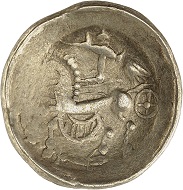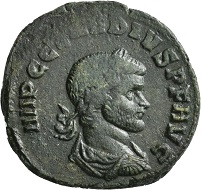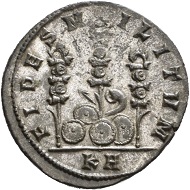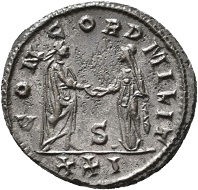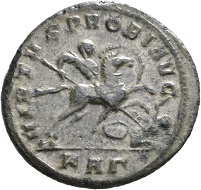12-09-2018 – 13-09-2018
Auction 44 – Coins and Objects from Antiquity, literature & Auction 45 – Gysen Collection of Eminent Antoniniani i.a. (253-294)
Rare coins of the barracks emperors in upcoming Jacquier auction
Paul-Francis Jacquier will hold two auctions on September 13th and 14th. The first one on Thursday, September 13th, is the traditional fall auction which will encompass the entire spectrum of ancient numismatics as well as a large range of literature. The next day, Friday, September 14th, is dedicated to the Philippe Gysen collection – a very important and extensive collection of the barracks emperors’ coins from 253 to 294. The reign of emperor Probus is especially well-documented.
No. 36. Helvetii (Switzerland / Southwest Germany). Electrum stater, late second to first third of the first century BC. Very rare. Very fine. Estimate: 2,000 euros.
Celtic coins from France, Belgium, and Switzerland
The auction will open with 36 lots of Celtic coins made of gold, electrum, silver, and potin. A remarkable piece is the extremely rare Allobroges drachm with the inscription “Ialkovesi” in Lepontine lettering and the depiction of a detailed horse head. The most expensive piece is likely to be the electrum stater of the Helvetii. This very rare coin was minted in the late second or early first century.
No. 72. Argilos (Macedonia). Bronze, ca 375-365. Fourth known specimen. Extremely fine +. Estimate: 750 euros.
Greek coins
Next up are more than 100 lots of Greek coins including some great rarities of exceptional grade, for example the bronze tetras from the Sicilian island of Lipara, which depicts the god of the winds Aeolus on its obverse.
Connoisseurs will rejoice over the bronze from the Macedonian Argilos, of which only four specimens are known up to this day. Jacquier will offer the one which is undoubtedly the most well-preserved.
Only a few specimens are known of a drachm which was minted in the 220s BC on the Thessalian islands of Peparethos. The example stemming from the BCD collection, which was sold at Lanz in 2011, is the second known specimen.
No. 160. Cleopatra and Mark Antony. Bronze. 21 ( = 32/1 BC), Chalcis at the Anti-Lebanon Mountains. Rare. Slightly orange-colored sand patina. Extremely fine. Estimate: 850 euros.
Roman coins
Those who enjoy fine bronze coins, should pay close attention to Jacquier catalog 44. Among the approximately 300 Roman coins, Jacquier offers a variety of rare bronze coins featuring many details and gorgeous patina. One example is a bronze from Chalcis which depicts the portrait of Cleopatra on the obverse and Mark Antony on the reverse.
No. 165. Caligula for his brothers Nero, +31, and Drusus, +33. Dupondius, 37-38. RIC 34. Red-green patina. Gem. Estimate: 3,500 euros.
Caligula had a gorgeous dupondius minted dedicated to his late brothers Nero and Drusus. Other rare pieces of this section are a semis (!) of Titus, a sestertius of Domitian and of Iulia Paula.
No. 198. Lucius Verus, 161-169. Bronze medallion, Rome, 164. Unedited unique specimen. Dark green patina. Nearly extremely fine. Estimate: 15,000 euros.
A bronze medallion of Lucius Verus, struck in Rome in 164 AD, will appeal to experienced collectors. The unedited unique specimen depicts a very detailed image of a ship on its reverse.
No. 341. Tacitus, 275-276. Aureus, Siscia, 276. RIC 175. Very rare. Nearly extremely fine. Estimate: 5,000 euros.
As per usual at Paul-Francis Jacquier, we will find an abundance of rarities among the barracks emperors’ coinages. Not only the small series of 40 coins of Postumus but also an aureus of Tacitus, minted in Siscia in 276, are part of this selection.
No. 361. Magnia Urbica, wife of Carinus. Denarius, Lugdunum, summer of 284, RIC 338. Fourth known specimen. Estimate: 5,000 euros.
While you will find antoniniani of Magnia Urbica quite frequently, her denarii are much rarer. Jacquier offers the fourth known specimen of an issue which was minted in the summer of 284 in Lugdunum for the wife of Carinus.
No. 469. Italic quatrefoil fibula. Hallstatt period, ca 750-600 BC. Estimate: 500 euros.
Coins of the Byzantines, the crusaders, and several Paduans are followed by the “Objects from Antiquity” section including a small series of fibulae.
No. 2587. Canessa, C. & E. Naples, June 28, 1923. Collectione del fu Comm. Enrico Caruso Monete e Medaglie in Oro. 1458 lots, 104 pp., 64 plates, Estimate: 100 euros.
Afterwards, about 500 lots of literature, mostly on ancient topics, will be offered. Just like in previous years, there will be 230 lots of duplicates from the BCD collection. The owner added short inspiring notes to every single book which explicitly explain what makes each book desirable.
Among interesting monographs and numerous early numismatic magazines, this time you will also find a large selection of very early and rare auction catalogs some of which contain exceptional collections. For example, the collections of the tenor Enrico Carusco, the archaeologist A. S. Rhousopoulos, the manufacturer A. S. Bement, and last but not least, the famous Montagu collection, which was auctioned off at Sotheby, Wilkinson & Hodge in 1896.
No. 1148. Aurelian, 270-275. Antoninianus. First issue. Dec. to Jan. 217. RIC online 1416 (this specimen depicted). Only two known specimens. Extremely fine. Estimate: 500 euros.
Auction 45: Philippe Gysen Collection – Part 1
On Friday, starting at 4:00 pm, the Philippe Gysen collection of coins from the barracks emperors period will be auctioned off. It encompasses a variety of rarities which only exist in a few examples. The collector, who is actually an expert in biomedicine, began collecting coins at the tender age of 14. He was lucky as he met other collectors in the numismatic club of Liège who encouraged him to specialize in a small field.
No. 1044. Saloninus, 260. Antoninianus, Cologne, July / August 260. Very rare. Very fine. Estimate: 750 euros.
Philippe Gysen decided to focus on the coinages of Probus. Thus, the antoniniani of his reign constitute the key element of the collection of more than 3,700 coins. A first part is now being auctioned. It includes coins, mainly antoniniani, from Gallienus up to the tetrarchy.
No 1079. Claudius Gothicus, 268-270. As, Rome, first issue, December 268 to the beginning of 269. Rare. Very fine. Estimate: 750 euros.
Both beginners and specialized collectors will find something of interest in this auction. After all, what originally motivated Philippe Gysen to collect the coins of Probus is still valid: “His coinage is abundant and diverse due to its various bust types and the reverses … and at conventions and in auction catalogs the items are still estimated at a very reasonable price.”
No. 1547. Probus, 276-282. Antoninianus, Siscia, third issue, 277. Probably unpublished. Nearly extremely fine / Very fine. Estimate: 1,000 euros.
And they still are up to this very day. What is more, these coinages offer the collector the opportunity to contribute their share to the discipline. The Gysen collection, for example, was filed in detail for the digital version of the new RIC.
No. 1286. Tacitus, 275-276. Antoninianus, Ticinum, second issue. First half of 276. Third known specimen. Extremely fine. Estimate: 1,000 euros.
For many numbers, it offered either the only or the most well-preserved specimen, which was therefore depicted in the new RIC online.
No. 1537. Probus, 276-282. Antoninianus, Siscia, second issue, 276. Extremely rare. Extremely fine. Estimate: 2,000 euros.
Of course, the collection is especially abundant in rarities relating to emperor Probus.
No. 1596. Probus, 276-282. Antoninianus. Siscia, sixth issue, 281. Extremely rare. Unedited to date. Nearly extremely fine. Estimate: 1,000 euros.
This section even presents bust types which were completely unknown until now. One example is an antoninianus from 281 featuring the emperor holding a club.
No. 1688. Probus, 276-282. Antoninianus, Serdica, fourth issue, 280. Very rare. Nearly extremely fine. Estimate: 500 euros.
The numerous special legends as they appear on coins from the Serdica mint are especially popular amongst collectors. Whether it may be PERPETVO IMP C M AVR PROBO AVG, BONO ET INVICTO PROBO P F AVG, BONO IMP C PROBO INVICTO P F AVG, IMP DEO ET DOMINO PROBO AVG, DEO ET DOMINO PROBO INVICTO AVG or IMP C M AVR PROBO P F INVICTO AVG, collectors will find a vast selection. Yes, he will even find a legend where the die cutter made a mistake and mixed up dative and nominative, as seen in IMP C M AVR PROBVS P F INVICTO (sic!) AVG (Nr. 1629) oder BONO IMP C M AVR PROBVS (sic!) AVG (No. 1677).
No. 1784. Julian of Pannonia, 284-285. Antoninianus, Siscia. Second half of December of 284. Very rare. Extremely fine. Estimate: 2,500 euros.
Whether it is Julian of Pannonia or Carausius, all of the rare rulers of this period are represented in the collection.
No. 1816. Maximianus Herculius, 286-305 and 307-310.Tetradrachm, Alexandria, ca fall of 298. Nearly extremely fine. Estimate: 1,000 euros.
Connoisseurs of the Alexandrian coinage should also take a look at the catalog as two rare tetradrachms of Maximianus from Alexandria are being offered here.
You can purchase both of the fully illustrated catalogs at a token charge of 15 euros directly at Paul-Francis Jacquier, Honsellstr. 8, D-77694 Kehl am Rhein, phone: +49 7851 / 1214, e-mail: office@coinsjacquier.com
In order to be able to bid online, please register in time at. https://auctions.live-bidder.com/clients/jacquier/en/
You can view the auction catalogs online:
On Sixbid, you will find auction 44 and auction 45.
On Numisbids you will find auction 44 and auction 45.





